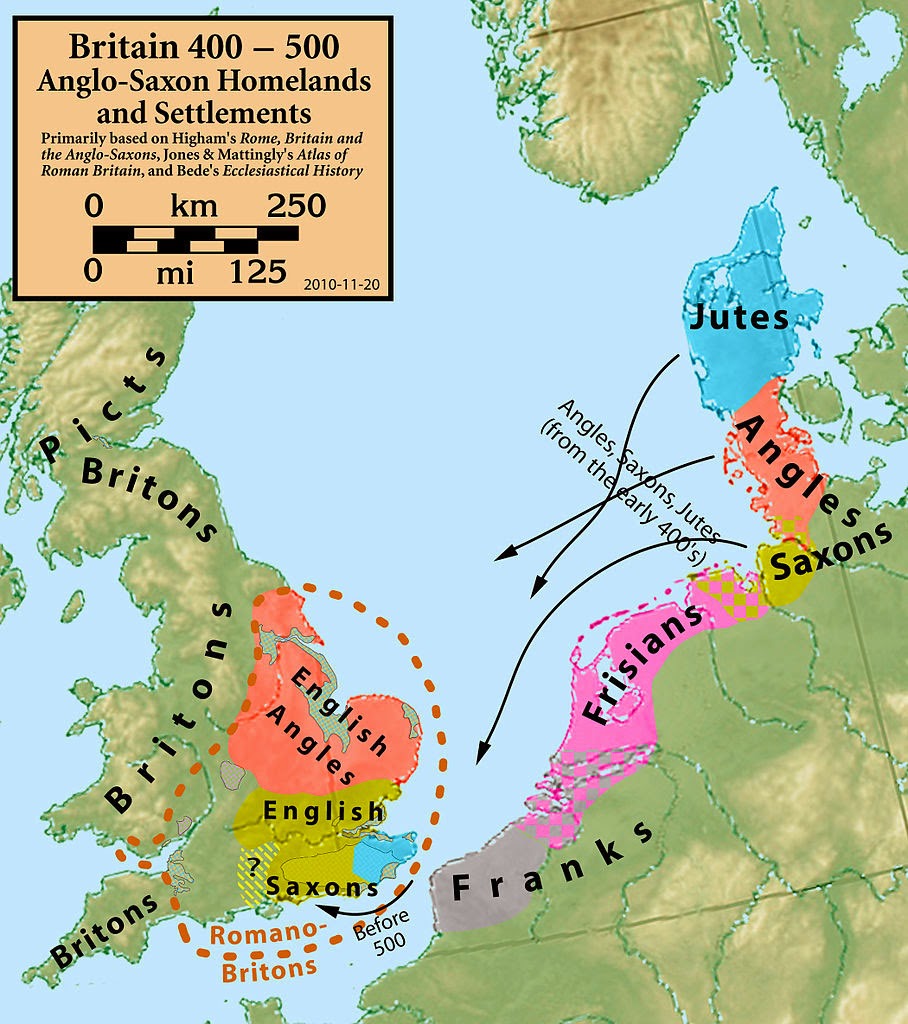The 6th century writings of Gildas' De Excidio et Conquestu Britanniae (On the Ruin and Conquest of Britain), our prime text for the period, tells of a brutal conquest by impious barbarian invaders from the east wiping out and replacing the indigenous population. Gildas “slash and burn” model has coloured all following accounts of the Post Roman period; Bede, the Historia Brittonum and the Anglo Saxon Chronicle which so closely follow his account that the adventus saxonum is now part of our national mythology.
 |
| Britain 400–500: Anglo-Saxon Homelands and Settlements (Wikimedia) |
Dr Millard said, 'The main controversy over the years has centred on how many Anglo-Saxons came across the North Sea.'
He continues, 'Was it a mass invasion, where the existing population was wiped out completely or forced back into Wales, or was it a small band of elites whose ways were then adopted very quickly?'
'Our evidence favours the second option.'
The team of archaeologists investigated the remains of 19 individuals excavated from an early Anglo-Saxon cemetery at Wally Corner, Berinsfield in the Upper Thames Valley, first discovered from aerial photographs in 1934.
Grave-goods from the cemetery, including weapons, knives, jewellery and pottery, indicate the site was in use as a burial ground for about 150 years from Bede's adventus saxonum in 449 AD through to the early 7th century, indicating the cemetery contained some of the earliest Saxon immigrants into Post-Roman Britain. Using information from tooth enamel samples the study team determined where these people are likely to have lived in childhood.
Clearly, the number of Saxon immigrants arriving in Britain is one of the key issues of the debate. For a mass invasion and people replacement to have taken place from the early/mid 5th century, the Oxfordshire graves would have been expected to contain around 20 per cent immigrant remains. But only five per cent of the buried individuals from the cemetery at Wally Corner seem to have come from outside the local area.
'Oxfordshire is quite some distance from the landing point of any invasion, but it seems that there was not a mass invasion everywhere,' says Dr Millard.
'The broader question is still open to debate, and we're still gathering evidence, but our evidence favours a scenario where there was not a wholesale replacement of the population, but a shift in culture.'
'By exploring this question, we hope that we can address the broader issue of how cultural change happens on a wide scale.'
It must be noted that this is one isolated case and further work is still required; however, the results favour a scenario where there was no wholesale replacement of the population, but a strong cultural shift.
The prime text for the period now demands reconsideration; was Gildas writing history?
>> Gildas and the Romans
Sources:
Anglo-Saxon Cemetery Results Question Violent Invasion Theory - Past Horizons
Susan S. Hughes, Andrew R. Millard, Sam J. Lucy, Carolyn A. Chenery, Jane A. Evans, Geoff Nowell, D. Graham Pearson, 'Anglo-Saxon origins investigated by isotopic analysis of burials from Berinsfield, Oxfordshire, UK' Journal of Archaeological Science, 2014
* * *
